More from the amazing Dingles Fairground Museum
Posted by Chris Graham on 24th May 2023
David Reed continues his report from Dingles Fairground Museum, looking at more of the fascinating exhibits, and trying the historic rides.

Dingles Fairground Museum: Not currently in operation at the museum, Robert Edwards’ Super-Sonic Skid ride looked different in the 1940s, when it was first acquired. (Pic: The Fairground Heritage Trust)
There’s a second set of gallopers in the Dingles Fairground Museum’s collection but, at present, this ride remains in storage, as it awaits restoration. This ride was also operated by Robert Edwards & Sons, and was bought by them in 1916 from Halsteads, roundabout manufacturers and brokers from Sowerby Bridge, Yorkshire, for the sum of 80 sovereigns. It’s been established that the ride was built by Savages of Kings Lynn, probably well before the turn of the century. Although the previous owners are unknown, it may have originally been made as a four-abreast machine with 48 mounts. Later though, it carried 36 carved wooden mounts, fixed three-abreast, made up of 24 horses and 12 double-seater cockerels which were carved by Andersons of Bristol.
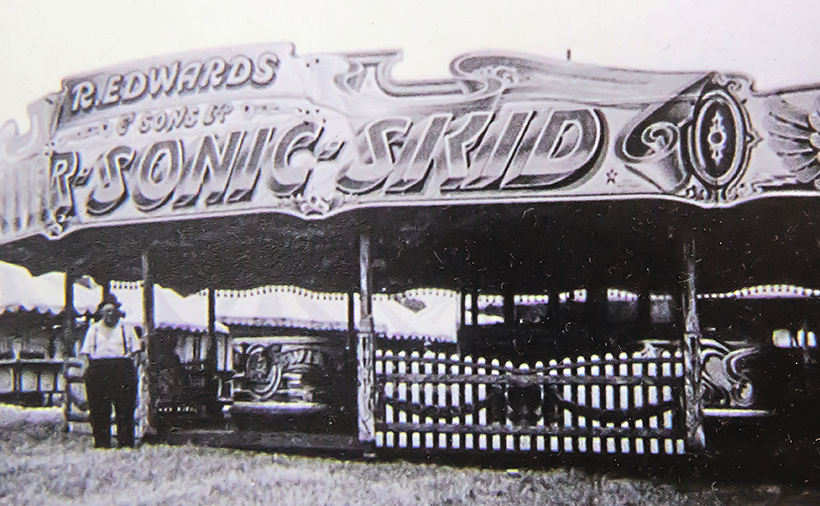
Albert Edwards seen with the skid when still on tour.
With the ride’s diameter being 42ft, it was built up with 12 platforms and was powered by a steam engine in the centre, named Little Beauty, that was built by Robert Tidman & Sons of Bishop Bridge Iron Works in Norwich. The ride was never converted to run on electricity, although it was fitted with electric lights, while the original 89-key Marenghi organ was replaced in 1931 with a brand new 89-key organ purchased from J Verbeeck & Sons of London, for £1,000. It was mounted on the same organ truck and stood in the centre of the roundabout when in use. This organ is on display in the museum, as is some of the transportation that was used when the ride was on the road.

The skid is now set up at Dingles, although it’s not in operation at present due to the floor panels needing to be refurbished.
Bought in 1922, the vehicle used was an American-built FWD general service lorry, many of which were supplied to the Allies from 1916, and was a standard army truck from WWI. This vehicle was re-built at Slough after being repatriated, and was used to carry the horses and cockerels from the gallopers, as well as tow the organ truck. As for the heavy wooden platforms, structural woodwork and carved wooden panels, they were all carried in the ‘Jumbo’ packing truck, also to be seen at Dingles.

New scenery was constructed during the 1950s with the artwork being completed by Hall & Fowle, with the ride continuing to travel until the 1970s.
The end of the ride was in sight though as, in 1933, the gallopers were packed away in Edwards’ yard after a new electric Noah’s Ark ride was purchased. And there they stayed until 1986 along with the organ and transport vehicles until they were acquired by the Science Museum. The ride was unpacked and built up in 1987 at the Science Museum’s store at Wroughton Airfield but, although it was in good condition overall, and restoration had started, it was obvious that there was a tremendous amount of work to do. Unfortunately, work on the ride was halted and, in 2006, the gallopers moved to Dingles with restoration hopefully continuing sometime in the future.
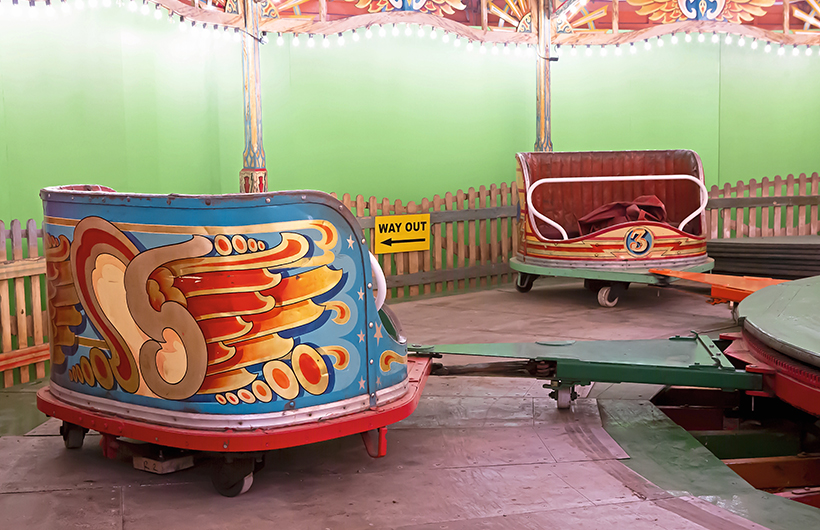
Riders sat in waltzer-like cars which were dragged around an oval track with speed and centrifugal force both being experienced.
Moving on, and arguably the most spectacular looking ride in the museum is Robert Edwards & Sons’ Super Chariot Racers, that was built in 1932 by Orton & Spooner of Burton-on-Trent, at a cost of £1,750. The story goes that the ride was delivered to Cheltenham railway station but, to raise enough money to pay for transport, Robert Edwards had to open the ride in nearby St Paul’s Street until he could pay the bill.

All the cars were highly decorated, and resembled cars that were used on waltzer rides.
The ride measures 42 feet in diameter, plus the porch and steps, and was decorated by Sid Howell in the Art Deco ‘jazz’ style which was popular in the 1930s. As was the thirst for speed and, in 1936, the outside row of animals was replaced by motorcycles complete with chrome trim and safety barrier. In my day, even riding the motorcycle on these rides was deemed a bit tame; the thrill was to stand against the barrier and lean towards the centre of the ride to compensate for the centrifugal force, no health and safety then!
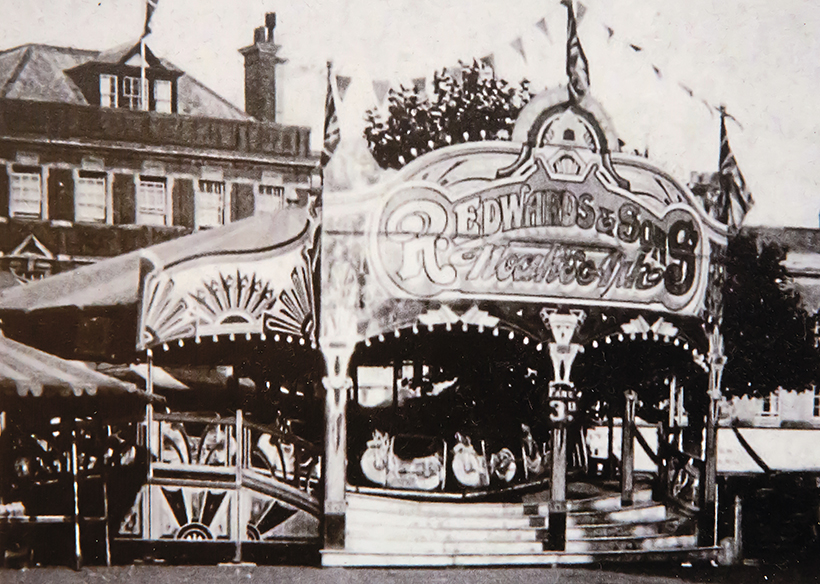
Robert Edwards’ Noah’s Ark as it was in the 1930s before being renamed as his Super Chariot Racer. (Pic: The Fairground Heritage Trust)
To embellish the ride still further, after the war it was rebuilt with the enormous Chariot Racer scene on the front boards, that was constructed at Orton & Spooners and painted by its artists, Sid and Albert Howell. The Chariot Racer had a long life with the Edwards family, travelling with them until 1991 when it was placed in store in Swindon until it was acquired by the Fairground Heritage Trust, in 1993. The ride arrived at the site in 2006 and, with the help of Frank Edwards, was assembled within a fortnight of arriving at its new home, and opened to the public later that year, a magnificent ride indeed.
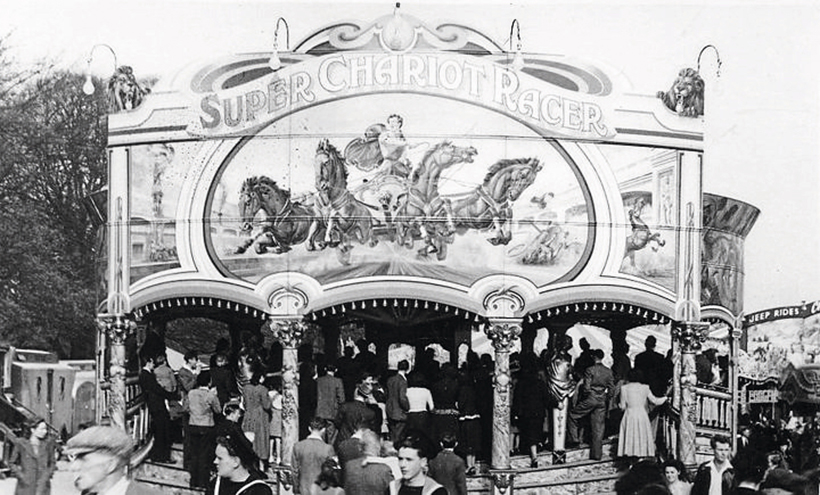
The Chariot Racer was an obvious attraction when it was at Hampstead Heath in 1947. (Pic: The Fairground Heritage Trust)
Although not on display at the present time due to restoration work, the oldest ride in the Trust’s collection is a Rodeo Switchback ride that’s believed to have been built by Savages of Kings Lynn around 1880 for James Pettigrove, possibly as a Velocipede. Although its early history is unknown, it’s thought to have started out as a very plain machine, being acquired by Peckham Rye showman William Wilson around 1925, who then travelled with it until his death in 1942. During that time, it was extensively rebuilt by Orton & Spooner; a completely new lower half of the machine was constructed over the winter of 1926/7, with the ride being fitted with a succession of exotic cars. Initially, Wilsons had animal cars installed, including elephants and bears, but later more exotic figures were added, including Hollywood silent film stars such as Harold Lloyd, Jackie Coogan and Tom Mix. These are the cars that survive today, while other alterations at the time included the steam centre engine being discarded, with the ride being permanently electrified by Allens of Oxford.
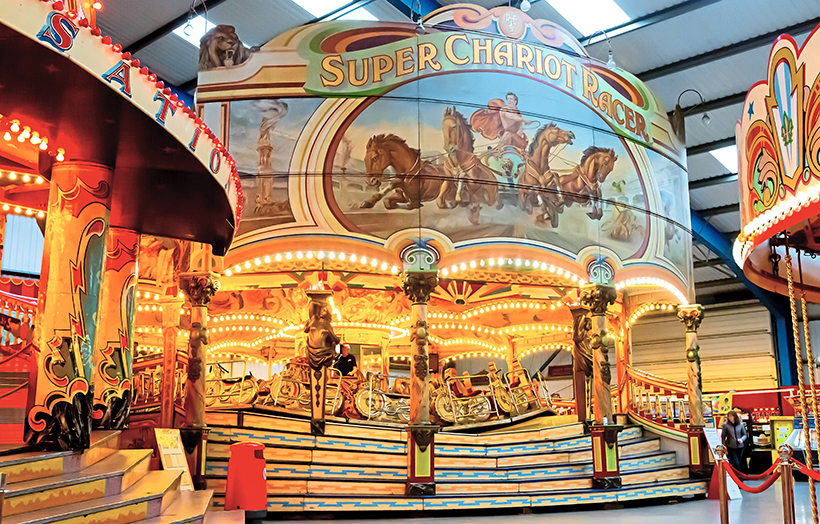
The Chariot Racer as it now stands at Dingles; a magnificent and traditional fairground ride.
The ride continued to be used into the 1970s, mostly at Billy Manning’s Clarence Pier Amusement Park in Southsea, until being sold to Jimmy Williams in 1973. He restored the ride and travelled it in 1974, when it was sold to the Six Flags theme park in New Jersey, USA. Sadly, it was only used for a short time, before being laid aside. Luckily it was saved though, with a consortium being formed in 1982 to rescue and return it to the UK before it was destroyed. Those efforts were successful, with the switchback making its debut at the Great Dorset Steam Fair in 1984, after which it continued to travel for seven years. In 1992 the decision was taken to sell the ride and, in 1993, it was acquired by the Fairground Heritage Trust.
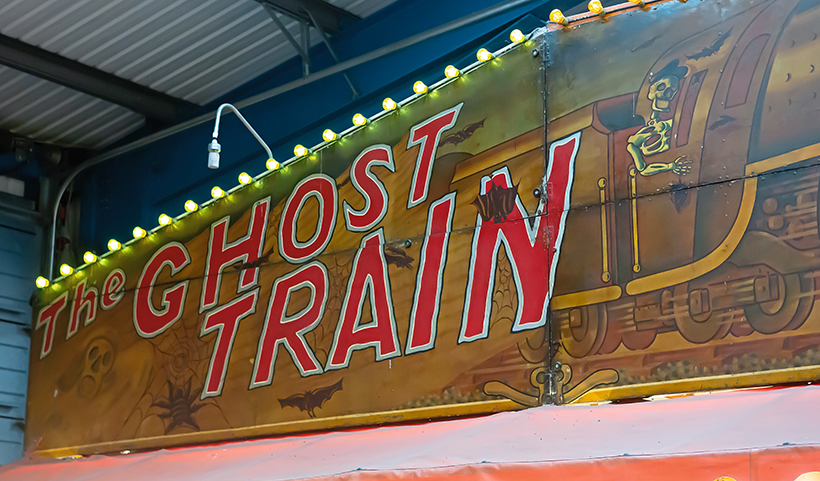
Built in 1947 by Amusement Supplies Ltd, the front boards of Mrs Elizabeth Brett’s Ghost Train were originally decorated in 1949 by Hall & Fowle.
Also of interest was Mrs Elizabeth Brett’s Ghost Train, built by Amusement Supplies Co in 1947. This ride was originally owned by Joe Stevens and was decorated in 1949 by Hall & Fowle, with the front and station being possibly the earliest example of the company’s work. Since 1948 the ride has remained primarily unaltered, and was sold in around 1952, travelling with John & Elizabeth Brett and, later, with their son John, who took it all over the country. After being acquired by the FHT in 1994, it was restored in 2010, with the team of volunteers being led by Kevin Gamlen, to 1950s decoration with new interior effects being supplied by Richard Cadell. It is rare as this ghost train is built up from the floor rather than being built into a trailer, as most ghost trains were.
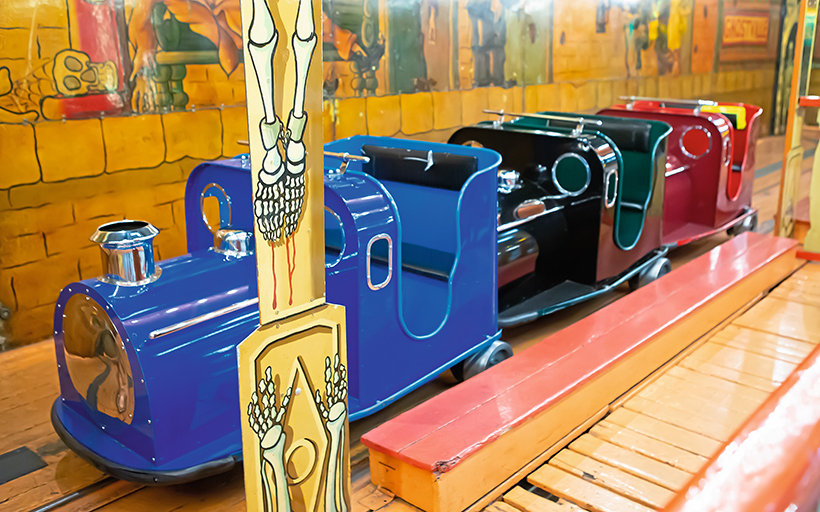
The trains at the station on the ghost train. The ride was restored in 2010, with the team of volunteers being led by Kevin Gamlen, to 1950s specification.
There are some operational juvenile rides on site, too, notably a Jackson Mini Waltzer that came from Charlie Manning’s Park at Felixstowe. This was initially painted plainly with the addition of some vinyl stickers. The ride has now been refurbished, with local artist and showman Chris Thomas being commissioned to redecorate it in this traditional style. Also on show is Philip Noble’s ‘toytown’ juvenile ride (on loan to Dingles), a roundabout which has been updated over the years with more modern ‘toys’ being added.
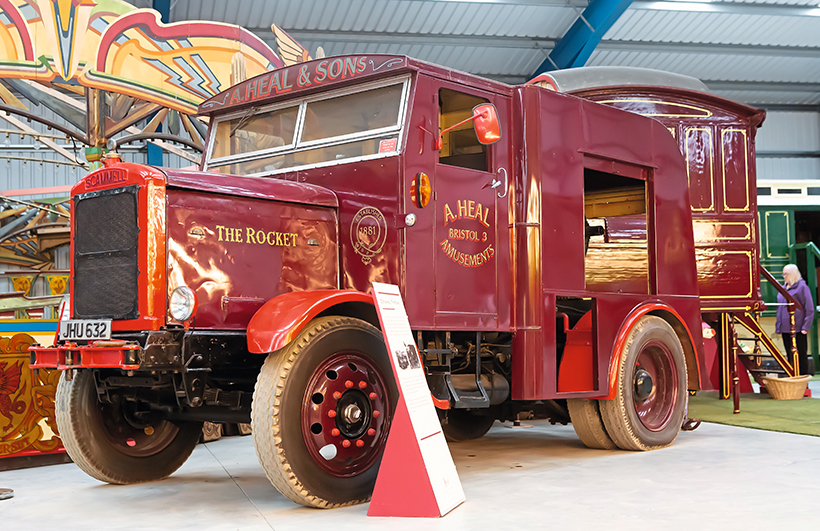
This chain-driven 1946 Scammell CD45 was with Charles Heal from the late 1940s, and is powered by a Gardner diesel engine.
There are also some traditional sideshows to enjoy, some boasting a ‘prize every time’ while coconuts can also be won. You can try your skill at a darts and ball-throwing. The ball side show travelled the West Country with Thomas Hutchins, and is on loan from Sarah and Henry Chipperfield, while the plate-smasher stall is a popular attraction which travelled in the south-west for many years with Chris Davies.
Then there is the Webley Rifle Range, which travelled with Mushie Brett in the 1950s, when popular prizes included china tea services. The attraction was donated by the Thomas family, and was redecorated by Chris Thomas over the winter of 1998/99, and was built up at Dingles in 2012. The stall features its original, decorated hangings and a display of vintage prizes, with original finger box targets being installed in one half of the stall for adults to practice their shooting skills using rifles with pellets. The other half has been set up as a cork-shooter for the children.
Then there’s a food stall on display that was built by Fred Barker of Idle, around 1954, and was decorated by Willie Driver for the Finnie family, while another van serves refreshments for those wanting a break from all the excitement!
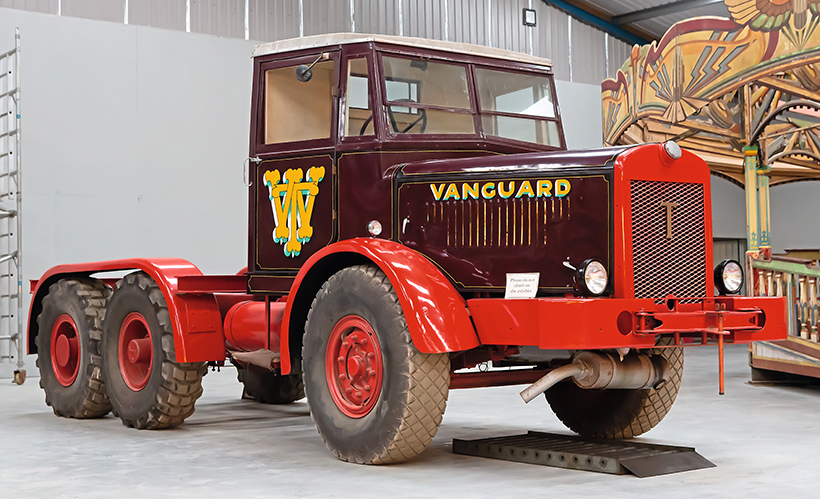
This Thornycroft Amazon Vanguard was initially built for WWII and later used by Whitelegg’s Amusements. It’s on loan from Mitzi & Chris Stapleton.
Moving onto some fairground vehicles, JHU 632 is a 1946 Scammell CD45 that was acquired by Charles Heal in the late 1940s, and was used with the family’s funfair. Powered by a Gardner diesel engine and chain-driven, it was restored by the late Albert Heal in the 1980s, and is on loan to Dingles from Charles Heal’s grandson, also named Charles Heal. Also to be seen is a mighty Thornycroft Amazon named Vanguard that was initially built for WWII and later used by Whitelegg’s Amusements. This exhibit has been rebuilt and is on loan from Mitzi & Chris Stapleton, while having a more modern feel is A68 OCX, a 1984 ERF C Series that was with Marshalls in Yorkshire. It was soon to be seen on the fairgrounds as a generator vehicle though, and was with Howard Maden, being used in conjunction with the Shaw’s Moonrocket Ride that is now on display at Dingles.
There are a number of vintage fairground caravans on display, too, with one of the oldest being Dr Edwin Laurence’s Bioscope wagon. This was one of two wagons used by him in conjunction with his cinematograph show that were built by Orton & Spooner, both of which were used as an ornate show front during the early 20th century. It was described by Laurence as ‘the handsomest front travelling, massively carved and gilded and the most comfortable home on wheels.’ Amazingly, it ended up in a Lincolnshire field where it stood for many years before being rescued, with just one corner having being restored in gold to show what the van would have looked like on the fairground.
Also to be seen is a 1940s van that was built by R Southern & Co Ltd of Brighouse, for William Noble. It was found on a farm in the East Riding of Yorkshire and has been restored with all the original fitted furniture still in place. Then there is an Orton & Spooner living van that was built before WWI for George De-Vey, a wagon that’s now owned by Delcia Phipps, while Bristol-based showman Charles Heal’s van was also worth a look.

One of the oldest caravans on site is Dr Edwin Laurence’s Bioscope wagon. It was one of two wagons used by him in conjunction with his cinematograph show.
This living wagon was ordered in the early years of the 20th century from George Orton of Burton-on-Trent, for Charles and his wife Agnes to travel the fairs of Bristol and Somerset with their galloping horse ride. The interior is also pretty special, and contains mahogany furniture, cut glass windows, wooden panelling, painted ceilings and a Hostess cooking stove. The van was restored by Charles Heal’s grandson, and is on loan to Dingles.
And there is so much else to see, with hook-a-duck, a hall of mirrors and slot machines to play on. As with many such museums, Dingles is always on the lookout for volunteers to work on restoring the rides and help with the general running of the museum. Donations of materials, paint, electrical fittings and equipment, and other useful items are most welcome, too.
During the winter months, the venue is open for visitors to experience the rides at night, there are carol concerts at Christmas, while the museum can also be hired for weddings. The museum is well worth a visit, with a lot of fun to be had, whatever your age. Dingles literally does provide all the fun of the fair. Check out opening times and general information on Dingles’ website by clicking HERE, you won’t be disappointed.
This feature comes from a recent issue of Old Glory, and you can get a money-saving subscription to this magazine simply by clicking HERE
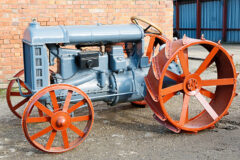
Previous Post
Amazing Richard Vernon dispersal sale previewed
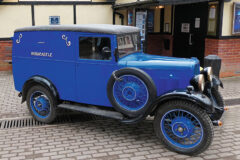
Next Post
Amazing 1934 Singer Nine van; it’s the sole survivor!



